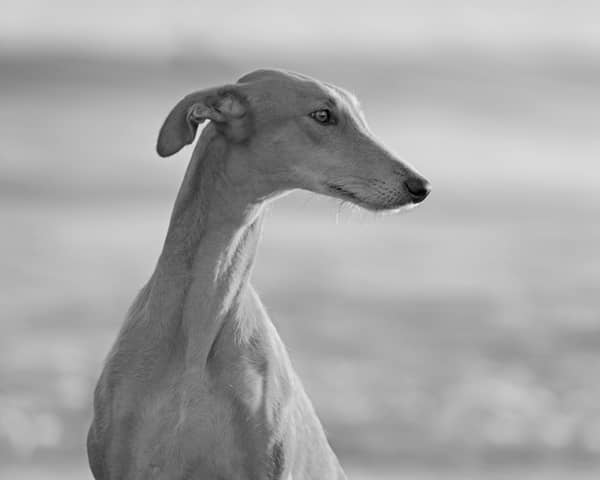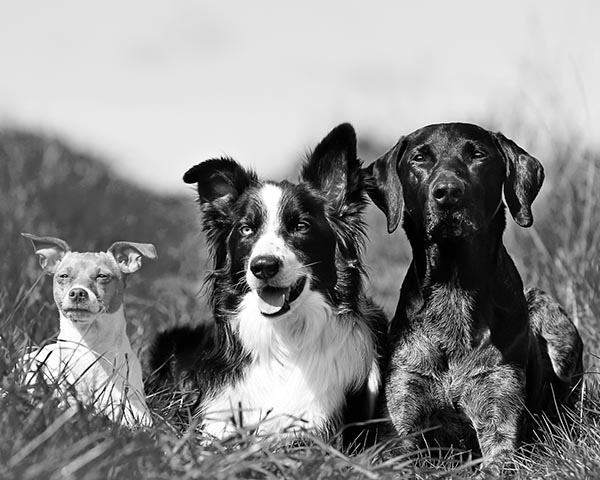Greyhound breed information and advice
Greyhounds are a gentle and noble breed. They’re laid-back, low-maintenance dogs that are great for families.
This guide will introduce you to the Greyhound, their lifespan, personality and healthcare needs.
Whether you are rehoming a retired race Greyhound or buying a Greyhound puppy, this guide will help you to prepare for your new arrival. Read on to learn what Greyhounds are like as pets.
Greyhound facts

| Lifespan | 10 – 13 years |
| How much | £400 – £2,500 |
| Size | 69 – 76 cm |
| Weight | 25 – 35 kg |
| Colours | Black, white, red, fawn, fallow, brindle, grey, blue |
| Grooming | Minimal – once a week |
| Temperament | Friendly, gentle, intelligent |
| Exercise | One hour per day |
Insurance for your Greyhound
Dog insurance can help cover the cost of unexpected vet bills for illness and injury. Some health problems are genetic, meaning your puppy could be born with a condition. Others are linked to old age and only found in adult dogs. So, make sure your dog is covered for its whole life by starting with puppy insurance.
Having Greyhound insurance helps to cover the cost of treatment, consultations, medication, nursing care or even surgery.
Common conditions that can affect Greyhounds include:
Sainsbury’s Bank Pet Insurance
With Sainsbury’s Bank Pet Insurance, you can cover your Greyhound from eight weeks old up to any age. So, if you’re adopting an older Greyhound, there’s still insurance available to you.
There are three types of cover you can get with Sainsbury’s Bank Pet Insurance:
- Lifetime – our most comprehensive cover with access to up to £10,000 towards vet costs each year.
- Maximum benefit – cover for illnesses, accidents and conditions of up to £6,000.
- Time limited – we’ll cover your dog for different treatments of up to £3,000 during the year.
Please note that we won't cover any pre-existing conditions and that terms, conditions, excesses, exclusions and limitations apply.
How to care for a Greyhound
Diet, exercise, grooming and training all play a part in keeping a dog fit and healthy. Get up to speed on how to keep your Greyhound’s happy and healthy.
Feeding and nutrition
Most Greyhounds are not greedy dogs, but if kept with other dogs they can become competitive. You will need to weigh their food and feed them once or twice a day. Stick to the same times where possible. This is particularly important if you have adopted an ex-race Greyhound as they’ll be used to a strict feeding routine. It'll also help make their transition to their new home easier and less stressful for them.
You should be able to find feeding guidelines on the back of your dog food packaging. You can also ask your vet, breeder or rescue contact if you’re unsure.
Grooming
Greyhounds are very low maintenance when it comes to grooming. They have a short, fine coat that doesn’t need grooming very often, but they do shed. Brushing once a week with a rubber brush or mitt will help to reduce the shedding. You’ll also be pleased to know that your Greyhound won’t need bathing very often either.
This breed doesn’t have much body fat and their thin coat doesn’t keep them warm. They’ll need to wear a coat or jumper on walks during the colder months to keep them cosy and healthy. If they get cold, they are more likely to get ill.
Exercise
You may expect the Greyhound breed to need a lot of exercise due to their racing associations. But they actually only need up to an hour a day. They are built for speed but don’t have good stamina. They use their energy in short bursts.
Greyhounds love to run so should be let off lead where safe to do so. But they have a strong prey drive and are prone to chasing animals, so you need to keep an eye on them, and only allow them loose in secure areas. If they chase an animal, they’re likely to catch it. They are very fast, with a top speed of 45 mph. Their long, powerful legs and lean bodies allow them to accelerate very fast – and they can reach their top speed within six strides.
Training
Training Greyhounds isn’t for the fainthearted. They’re a sensitive breed and can easily become fearful. They’re also not food-motivated so even tasty treats may not tempt them. But they are very intelligent dogs, so with time, patience and positive reinforcement, you will be able to successfully train your dog.
Bear in mind that once their chase instinct has kicked in, it’s hard to get their attention again. So, teaching your dog recall can be a challenge and is unlikely to be easy.
If you rescue an older dog, you may need to house train them too. Most race Greyhounds live in kennels, so are not toilet trained and will take some time to adjust to living in a house.
Temperament and behaviour
The Greyhound temperament is gentle, easy going and affectionate. Your dog will form a close bond with you and they can become lovely family pets.
If you’ve ever seen greyhound racing, you’ll see that the dogs wear muzzles. This may have led you to think that they have an aggressive temperament – but this is far from the truth.
If you adopt a retired Greyhound however, you will have to be careful around other animals. If they see a cat or rabbit, they will chase it, and if they catch it, they will harm it. This is not bad behaviour, they have been bred and trained to chase and they don’t know any different. To stop this from happening, don’t let your dog off lead unless it’s in a secure area where there are no other animals. You could also muzzle your dog when out of the house to be safe – until you’re confident in their behaviour.
Common health problems
Before taking your Greyhound to their fur-ever home, check what health problems you need to be aware of. Make sure you take out dog insurance as soon as you can as pre-existing conditions are not covered.
Von Willebrand’s disease (VWD)
Von Willebrand’s disease is inherited, so affected dogs should not be bred from. Von Willebrand’s factor is a protein that helps cells to stick to each other and form a normal blood clot in the body. Dogs with VWD have a reduced number of this factor, meaning that their blood doesn’t clot well.
Affected dogs are prone to bruising and bleeding. This can be dangerous if your dog is injured or needs surgery as it can cause continued bleeding.
Plasma and blood transfusions are given to help the blood to clot. A drip may be needed to replace fluid loss. In some severe cases, surgery is needed to stop the bleeding.
Gastric Dilation Volvulus (GDV)
Gastric dilation is when there is a build-up of gas in the stomach, causing it to inflate. It’s caused by fermentation of food or from swallowing hair. As the stomach swells it can flop to one side or even twist, which is known as GDV. This blocks the gases from escaping. It’s a serious, life-threatening condition, that can kill in less than an hour if left untreated.
Take your dog to the vet immediately if you notice these symptoms:
- Vomiting frothy foam
- Swollen and painful abdomen
- Difficulty breathing
- Collapse
Some dogs also cough and drink lots. If the stomach hasn’t twisted, it can be emptied of gas using a tube. This will take the pressure off the internal organs. But if it has twisted, surgery will be needed to open the stomach to empty it.
Affected dogs are at risk of recurring problems, so preventative measures should be taken, including:
- Smaller and more frequent meals
- Separation from other dogs while eating
- Restrict exercise before and after eating
- Put food bowl on floor – not raised on a stand
- Maintain a calm environment
Periodontal disease
Periodontal disease is also known as gum disease. It can cause gum erosion, tooth and bone loss and chronic pain.
Symptoms tend to include:
- Discoloured teeth
- Bad breath
- Bleeding or inflamed gums
- Favouring one side of the mouth when chewing
Treatment options depend on the severity of the condition, from good oral health care and professional dental cleaning to surgery and extractions.
Is a Greyhound right for you?
If you’re looking for an easy-going dog to join your family, a Greyhound would make the perfect addition. They have lower exercise needs than you may expect, and also minimal grooming requirements. They’re gentle, friendly and will bring you years of happiness.
Frequently asked questions
What is the life expectancy of a Greyhound?
The Greyhound lifespan is 10 to 13 years. There aren’t many fatal health problems linked to this breed. So, if fed the correct diet and exercised regularly, they are likely to reach their full lifespan.
Do Greyhounds get scared easily?
They are a sensitive breed that can be easily scared, making them wary of other dogs when they first meet them. Socialising your dog regularly, and from a young age, will help to teach them not to be afraid. Dogs pick up on human responses, so if you act calm, your dog will too.
Are Greyhounds good family dogs?
Yes, Greyhounds can be wonderful family companions. As a rule, as long as they’re socialized properly, their gentle, friendly and affectionate Greyhound temperament makes them great family pets.
How to rehome a Greyhound
If you are interested in getting a Greyhound, but not necessarily a puppy, there are many retired Greyhounds in need of rehoming at adoption centers that you could give a second life to in a loving home. Most race Greyhounds retire at the age of three to five years. They have a life expectancy of 10 to 13 years, so are still young and have many more years left in them.
For information about rehoming a retired Greyhound, contact your local Greyhound rescue center.

Browse our guides
Choose from our list of helpful guides and information

Explore dog breeds
Find out how to keep your dog healthy and happy

Cat breed guides
How to care for your cat, common health problems and more
Terms and conditions
Important information
Sainsbury's Bank plc, Registered Office, 33 Charterhouse Street, London, EC1M 6HA (registered in England and Wales, no 3279730) is authorised by the Prudential Regulation Authority and regulated by the Financial Conduct Authority and the Prudential Regulation Authority (register no. 184514).
Sainsbury's Supermarkets Ltd is an appointed representative of Sainsbury's Bank plc. Sainsbury's Bank plc acts as an introducer to Pinnacle Insurance Ltd who is authorised by the Prudential Regulation Authority and regulated by the Financial Conduct Authority and the Prudential Regulation Authority (register number 110866). Registered office: 4th Floor, Limelight, Elstree Way, Borehamwood, Hertfordshire, WD6 1JH. Sainsbury’s Bank Pet Insurance is arranged, administered and underwritten by Pinnacle Insurance Ltd. Sainsbury's Bank plc and Pinnacle Insurance Ltd are not part of the same corporate group.
We do not provide personal recommendations to customers.
